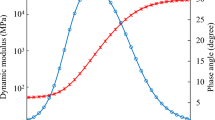Abstract
Reliable transverse crack prediction can benefit the design and maintenance and improve the reliability of field investigation for asphalt pavement in permafrost regions of Qinghai-Tibet plateau. This study adopted the crack prediction model in the newly developed pavement design method named Pavement ME Design (PMED) and the modified grey predictive model (GM (1, 1)) to predict the transverse crack of asphalt pavement in permafrost regions. The complementary advantages for the two models based on the weight distribution theory were discussed, and a combined prediction model (PME-DGM combination model) taking account into region characteristics was developed. Finally, the applicability of combined prediction model was analyzed. The result showed that, the predictive accuracy of PME-DGM combination model established by the error sum of squares reciprocal method was the highest, the best weight allocations for each sub-model were LNCH = 0.601 and LDGM = 0.399, and the combination model can be applied in the permafrost region involved in this paper; The combination model is more appropriate in predicting the development trend of transverse crack of project-level asphalt pavement in permafrost regions; For PMED predictive model, this study raised a modified method base on a third-party model (DGM (1,1), and the result showed that the method worked well in the permafrost region of Qinghai-Tibet plateau.
Similar content being viewed by others
References
Abaza, K. A. (2016). “Back-calculation of transition probabilities for markovian-based pavement performance prediction models.” International Journal of Pavement Engineering, vol. 17, no. 3, pp. 253–264, DOI: 10.1080/10298436.2014.993185.
El-Hakim, M., Jadoun, F. M., Lee, S., and Li, N. Y. (2014). “Sensitivity analysis of field-to-laboratory subgrade conversion factors with aashtoware pavement-me design.” Transportation Research Record Journal of the Transportation Research Board, vol. 2456, no. 1, pp. 115–123, DOI: 10.3141/2456-12.
Hong, F. and Chen, D. H. (2009). “Effects of surface preparation, thickness, and material on asphalt pavement overlay transverse crack propagation.” Canadian Journal of Civil Engineering, vol. 36, no. 9, pp. 1411–1420, DOI: 10.1139/L09-080.
Huang, B. S., Shu, X., and Vukosavljevic, D. (2011). “Laboratory investigation of cracking resistance of Hot-Mix asphalt field mixtures containing screened reclaimed asphalt pavement.” Journal of Materials in Civil Engineering, vol. 23, no. 11, pp. 1535–1543, DOI: 10.1061/(asce) mt.1943-5533.0000223.
Islam, M. R. and Tarefder, R. A. (2016). “Developing temperatureinduced fatigue model of asphalt concrete for better prediction of alligator cracking.” Journal of Materials in Civil Engineering, Vol. 28, No. 5, p. 4015193, DOI: 10.1061/(asce)mt.1943-5533.0001477.
Jiang, Y. and Li, S. (2005). “Gray system model for estimating the pavement international roughness index.” Journal of Performance of Constructed Facilities, vol. 19, no. 1, pp. 62–68, DOI: 10.1061/(asce) 0887-3828(2005)19:1(62).
Ker, H. W., Lee, Y. H., and Wu, P. H. (2008). “Development of fatigue cracking prediction models using long-term pavement performance database.” Journal of Transportation Engineering, vol. 134, no. 11, pp. 477–482, DOI: 10.1061/(asce) 0733-947x(2008)134:11(477).
Khattak, M. J., Baladi, G. Y., and Drzal, L. T. (2007). “Low temperature binder-aggregate adhesion and mechanistic characteristics of polymer modified asphalt mixtures.” Journal of Materials in Civil Engineering, vol. 19, no. 19, pp. 411–422, DOI: 10.1061/(asce)0899-1561(2007) 19:5(411).
Kim, S., Ceylan, H., Ma, D., and Gopalakrishnan, K. (2014). “Calibration of pavement me design and mechanistic-empirical pavement design guide performance prediction models for iowa pavement systems.” Journal of Transportation Engineering, vol. 140, no. 10, pp. 04014052, DOI: 10.1061/(asce) te.1943-5436.0000704.
Mallick, R. B., Tao, M. J., Daniel, J. S., Jacobs, J. M., and Veeraragavan, A. (2017). “Combined model framework for asphalt pavement condition determination after flooding.” Transportation Research Record: Journal of the Transportation Research Board, vol. 2639, pp. 64–72, DOI: 10.3141/2639-09.
NCHRP (2004). Guide for mechanistic-empirical design of new and rehabilitated pavement structures, NCHRP 1-37A Final Report, Transportation Research Board, Washington, D.C.
Sachs, S., Vandenbossche, J. M., and Snyder, M. B. (2015). “Calibration of national rigid pavement performance models for the pavement mechanistic–empirical design guide.” Transportation Research Record: Journal of the Transportation Research Board, vol. 2524, pp. 59–67, DOI: 10.3141/2524-06.
Shalaby, A. and Reggin, A. (2007). “Optimization of data collection needs for manual and automated network-level pavement condition ratings based on transverse variability and neural networks.” Canadian Journal of Civil Engineering, vol. 34, no. 2, pp. 139–146, DOI: 10.1139/L06-126.
Shi, L., Li, N., Li, G. Y., and Bi, G. Q. (2007). “Stability analysis of the awning in road engineering in permafrost regions.” Journal of Glaciology and Geocryology, vol. 29, no. 6, pp. 986–991, DOI: 10.3969/j.issn.1000-0240.2007.06.019.
Wang, P., Wang, Y. Z., Zhang, J., and Wang, Y. (2014). “Prediction model based on influencing factors of water consumption.” Journal of Drainage and Irrigation Machinery Engineering, vol. 32, no. 12, pp. 1051–1056, DOI: 10.3969/j.issn.1674-8530.14.0089.
Wen, H. F. and Li, X. J. (2012). “Development of a damage-based phenomenological fatigue model for asphalt pavement.” Journal of Materials in Civil Engineering, vol. 25, no. 25, pp. 1006–1012, DOI: 10.1061/(ASCE)MT.1943-5533.0000573.
Yang, J., Lu, H. Z., and Zhu, H. R. (2009). “Approaches to rut depth prediction in semi-rigid asphalt pavements.” Journal of Engineering Mechanics, vol. 135, no. 6, pp. 510–516, DOI: 10.1061/(asce) 0733-9399(2009)135:6(510).
Yang, X., You, Z. P., Hiller, J., and Watkins, D. (2015). “Sensitivity of flexible pavement design to Michigan’s climatic inputs using pavement ME design.” International Journal of Pavement Engineering, vol. 18, no. 7, pp. 622–632, DOI: 10.1080/10298436.2015.1105373.
Zhang, C., Wang, H. N., You, Z. P., and Ma, B. (2015). “Sensitivity analysis of longitudinal cracking on asphalt pavement using MEPDG in permafrost region.” Journal of Traffic and Transportation Engineering, vol. 2, no. 1, pp. 40–47, DOI: 10.1016/j.jtte.2015.01.004.
Zhang, Z. Q., Wu, Q. B., and Xun, X.Y. (2016). “Radiation and energy balance characteristics of asphalt pavement in permafrost regions.” Environmental Earth Sciences, vol. 75, no. 3, pp. 221, DOI: 10.1007/s12665-015-4975-5.
Author information
Authors and Affiliations
Corresponding author
Rights and permissions
About this article
Cite this article
Zhang, C., Wang, H., Yang, X. et al. A Combinational Prediction Model for Transverse Crack of Asphalt Pavement. KSCE J Civ Eng 22, 2109–2117 (2018). https://doi.org/10.1007/s12205-018-1867-8
Received:
Revised:
Accepted:
Published:
Issue Date:
DOI: https://doi.org/10.1007/s12205-018-1867-8




